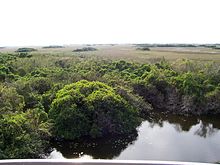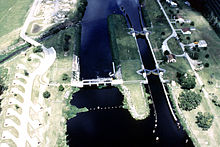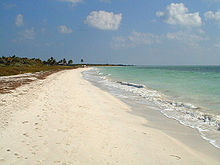- Environment of Florida
-
The state of Florida in the United States possesses a rich and diverse array of land and marine life and a mild subtropical climate. These assets have drawn millions of people to settle in the once rural state over the last hundred years; Florida's population increases by about 1,000 residents each day.[1] Land development and water use have transformed the state, primarily through drainage and infill of the wetlands that once covered most of the peninsula.
Much of Florida consists of karst limestone veined with water-filled caves and sinkholes,[2] which provide homes to many species of aquatic life, some unique to particular Florida locations.[3] As urban and suburban development have increased over the last decades, demand for groundwater has also risen, resulting in damage and drying out of portions of the cave system. This has led to ground subsidence as dry caves collapse, threatening property as well as ecosystems.[4]
Restoration of the Everglades has long been recognized as an environmental priority in the state. In 2000, Congress passed the Comprehensive Everglades Restoration Plan, a $7.8 billion, 30-year project aimed at preservation and restoration of the region and its unique combination of environments.[5]
Contents
History
Population growth and development
The 1900 United States Census identified only four cities in the state of Florida with more than 5,000 inhabitants: Jacksonville, Pensacola, Key West, and Tampa.[6] The total population of the state was recorded as 528,542.[7] The southern third of the state was sparsely populated, and much of it was partially submerged marshlands. A few attempts at diverting the flow of water from Lake Okeechobee to the land to the south had occurred as early as the 1880s,[8] but it was not until the election of Governor Napoleon B. Broward in 1904 that any significant drainage occurred. Broward had campaigned on a platform that included draining the Everglades and selling off the resulting land.[9] Beginning in 1906, and continuing until 1913, over 225 miles (360 km) of canals were dug, creating the Miami Canal, the North New River Canal, and the South New River Canal.[8] An even more ambitious and expansive program followed, resulting in the construction of six large drainage canals and numerous smaller canals, totaling 440 miles (710 km); 47 miles (76 km) of levees; and 16 locks and dams over a 14-year period, from 1913-1927.[8] As land was reclaimed from the Everglades, farmers moved in.[10] Vast farming areas sprang up in southeastern Florida and the northern Everglades.[11] Development was further spurred by the Florida land boom of the 1920s, during which a speculative wave resulted in a frenzy of planning, land redevelopment, and construction continued until 1926, when the bubble burst.[12] Between 1926 and the beginning of World War II, growth in the state was slow and relatively stable.
As World War II came to an end, thousands of people moved to Florida, bringing about a sharp population increase. The state's population in 1940 was 1,897,414; in 1950, it was 2,771,305, an increase of 46.1 percent. [13] The Tampa Bay area and South Florida were the biggest-growth areas, although almost all of the coastal areas along the peninsula saw strong growth.
By 1945, a prolonged drought in Florida spotlighted the first signs of the consequences of altering the environment. Saltwater intrusion became an issue in wells in the southern part of the state, and large wildfires consumed parcels of farmland, destroying the peat which had made the land so fertile.[8] Prior to instituting controlled burns, the state forests and pastures burned for months during the dry season. From the 1940s to the 1970s, the state and federal government assumed control of burning that prevented uncontrolled fires.[14] In 2010, the state burned a record 2,600,000 acres (11,000 km2).[15]
Extensive flooding in 1947, during which 90 percent of the state south of Orlando was underwater, made it clear that the current drainage projects were not beneficial to the environment, to farmers, or to the developing cities.[8] 1947 was also the year that Everglades National Park was dedicated,[16] and the year in which Marjory Stoneman Douglas published The Everglades: River of Grass, which warned of the damage that had occurred to the fragile ecosystem. The following year, the state of Florida created the agency which eventually became the South Florida Water Management District, responsible for water quality, flood control, water supply and environmental restoration in 16 counties, from Orlando to the Florida Keys.[17]
To control flooding, the Kissimmee River was straightened from 1962 to 1970. After environmentalists complained, it was unstraightened starting in 1997. It is expected to be completed in 2011.
During the 1960s and 1970s, continued growth along both coasts of the state and along Interstate 4 increased the strain on the ecosystems of the state. Portions of Big Cypress Swamp were drained for development, until the creation of Big Cypress National Preserve in 1974.[18] Additional acreage was added to Everglades National Park in 1989.[19] In 2000, Congress passed a federal effort to restore the Everglades, named the Comprehensive Everglades Restoration Plan (CERP), with the objectives of "restoration, preservation and protection of the south Florida ecosystem while providing for other water-related needs of the region."[20] and claiming to be the largest environmental restoration in history. The plan involves cooperation between the federal government, state, and local governments, and encompasses 18,000 square miles (47,000 km2) in 16 counties.[21] It is estimated that completion of the program will take 30 years, at an approximate cost of $7.8 Billion.[21]
As the Southeast Florida area approached buildout, growth shifted to more rural areas in central and north Florida. Between 2000 and 2006, Flagler County was the fastest growing county in the nation, and both Osceola County and St. Johns County were among the 25 fastest growing;[22] Flagler County was identified as a Metropolitan Statistical Area on 18 December 2006.[23] The sharp growth in Flagler County (and neighboring St. Johns County) has had a negative impact on the Guana Tolomato Matanzas National Estuarine Research Reserve,[24] endangers wildlife such as manatees and bears,[25] and threatens the water supply for the region.[26]
Resources
Governor Charlie Crist and both of Florida's senators, Bill Nelson and Mel Martinez, oppose offshore drilling and exploration. Former governor Jeb Bush, originally opposed to all drilling,[27] changed his position on a bill introduced introduced into the House of Representatives in 2005, which would allow unrestricted drilling 125 miles (201 km) or more from the coast.[28] Martinez, Nelson, and Crist opposed that bill, but Martinez and Nelson voted for a Senate alternative which prohibited drilling within 125 miles (201 km) of the Panhandle coast, and 235 miles (378 km) of the peninsular coast.[29]
In 2006, the state enacted "Farm to Fuel" initiative, an effort to increase production of renewable energy from crops, agricultural wastes and residues produced in the state of Florida.[30] On 22 January 2008, Florida's Agriculture and Consumer Services Commissioner announced funding for four commercial ethanol and biodiesel production facilities, and an additional eight demonstration and research projects.[31]
Energy, water, and waste management
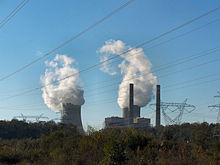 Crystal River North steam complex, in Crystal River, Florida
Crystal River North steam complex, in Crystal River, Florida
Florida ranks forty-fifth in total energy consumption per capita, despite the heavy reliance on air conditioners and pool pumps. This includes coal, natural gas, petroleum, and retail electricity sales.[32] It is estimated that approximately 4 percent of energy in the state is generated through renewable resources.[33] Florida's energy production is 6.0% of the nation's total energy output, while total production of pollutants is lower, with figures of 5.6 percent for nitrogen oxide, 5.1 percent for carbon dioxide, and 3.5 percent for sulfur dioxide.[33]
There are two oil-producing areas in Florida. One is in South Florida, with 14 fields, and the other is in the western panhandle, with seven fields. The South Florida fields are located in Lee, Hendry, and Collier county. Florida’s first oil field, the Sunniland field, in Collier County, was discovered in 1943. It has since produced over 18 million barrels of oil. Subsequently, 13 more field discoveries were found. Although these fields are relatively small, production is significant. Together, the three Felda fields (West Felda, Mid-Felda, and Sunoco Felda) in Hendry County have produced over 54 million barrels of oil.[34]
Production in the western panhandle began with the discovery of the Jay field in June 1970. Jay is the largest oil field discovered in North America since the discovery on the Alaskan North Slope of the giant Prudhoe Bay field in 1968. Since then, an additional six oil fields have been discovered in the western panhandle of Florida. North Florida has dominated Florida oil production since the discovery of the Jay field. North Florida oil fields account for 83 percent of the state’s cumulative production, with the Jay field alone responsible for 71 percent of the state’s cumulative production.
It is believed that significant energy resources are located off of Florida's western coast in the Gulf of Mexico, but that region has been closed to exploration since 1981.[35]
In July 2007, Florida Governor Charlie Crist announced plans to sign executive orders that would impose strict new air-pollution standards in the state, with aims to reduce greenhouse-gas emissions by 80 percent of 1990 levels by 2050. Crist's orders would set new emissions targets for power companies, automobiles and trucks, and toughen conservation goals for state agencies and require state-owned vehicles to use alternative fuels.[36]
Florida obtains much of its drinking water from the Floridan Aquifer and the Biscayne Aquifer, as well as from surface water from Lake Okeechobee and other lakes, but population increases have begun to strain available sources. The state has built 120 desalination plants, more than three times as many as any other state,[37] including the largest plant in the United States.[38] Additionally, an electrodialysis reversal plant in Sarasota is the largest of its type in the world,[39] and a nanofiltration plant in Boca Raton is the largest of its type in the western hemisphere.[37]
Increasing landfill space is also an issue. St. Lucie County is planning to experiment with burning trash through plasma arc gasification to generate energy and reduce landfill space. The experiment will be the largest of its kind in the world to date, and begin operation no later than 2009. If successful, experts estimate that the entire St. Lucie County landfill, estimated to contain 4.3 million tons of trash, will disappear within 18 years. Materials created in the energy production can also be used in road construction.[40]
Parks
See also: List of Florida state parks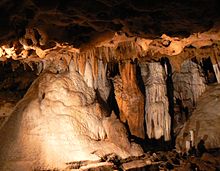 Caverns at Florida Caverns State Park
Caverns at Florida Caverns State Park
Areas under control of the National Park Service include:
- Big Cypress National Preserve, near Lake Okeechobee
- Biscayne National Park, in Miami-Dade County south of Miami
- Canaveral National Seashore, near Titusville
- Castillo de San Marcos National Monument, in St. Augustine
- De Soto National Memorial, in Bradenton
- Dry Tortugas National Park, at Key West
- Everglades National Park in Southern Florida
- Fort Caroline National Memorial, at Jacksonville
- Fort Matanzas National Monument, in St. Augustine
- Gulf Islands National Seashore, near Gulf Breeze
- Timucuan Ecological and Historic Preserve, in Jacksonville
Areas under the control of the USDA United States Forest Service include:
- Apalachicola National Forest along the east bank of the Apalachicola River,
- Choctawhatchee National Forest near Niceville,
- Ocala National Forest in Central Florida, and
- Osceola National Forest in Northeast Florida.
The National Oceanic and Atmospheric Administration's National Ocean Service is responsible for one sanctuary:
Biodiversity
Florida is a biodiverse state, with 3,500 native vascular plants and 1,500 vertebrates, a higher number than all but three other states.[41] A 2003 United Nations Food and Agriculture Organization study stated that the Florida Straits had the highest biodiversity in the Atlantic Ocean, and were the home to 25 endemic species.[42]
Flora
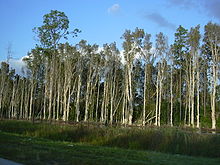 Dense stand of Melaleuca in the Everglades
Dense stand of Melaleuca in the Everglades
Red tide has also been an issue on the southwest coast of Florida. While there has been a great deal of conjecture over the cause of the toxic algae bloom, there is no evidence that it is being caused by pollution or that there has been an increase in the duration or frequency of red tide outbreaks.[43]
Fauna
 The Florida Scrub Jay is found only in Florida.
The Florida Scrub Jay is found only in Florida. See also: List of wild mammal species of Florida and List of Florida birds
See also: List of wild mammal species of Florida and List of Florida birdsEndemic species in Florida include the Florida Scrub Jay (Aphelocoma coerulescens),[44] Miami blue (Cyclargus thomasi bethunebakeri),[45] Okaloosa darter (Etheostoma okaloosae),[46] and Key Deer (Odocoileus virginianus clavium).[47]
Florida is a popular destination for birdwatching, because of the many species that can be found in the state at various times of the year. The Florida Ornithological Society maintains the official state list of the birds of Florida, which currently contains 498 species.[48] A study published in 2003 by the Florida Fish and Wildlife Conservation Commission documented 196 species of birds which were confirmed to breed in the state, with an additional 19 species listed as possible or probable breeders.[49] The Great Florida Birding Trail, a 2000-mile (3200 km) long trail, is composed of 489 locations throughout the state which are optimal observation sites. [50]
Sport fishing is also popular in Florida; over 250 different species of fishes (including 73 non-native species) can be found in Florida. There are more than 1000 species of fish in Florida's inshore waters.[51]
In 2010, NOAA, citing the Magnuson-Stevens Act, banned fishing of red snapper until the population has time to recover.[52]
Florida's Atlantic coast is home to the only extensive coral reefs in the continental United States,[53] and the third largest in the world.[54] The entire reef system in the Florida Keys is encompassed by the Florida Keys National Marine Sanctuary,[55] and significant portions of reef are protected as part of Biscayne National Park.[54]
In 1977, the federal government placed alligators on the endangered list. They were removed from the endangered list in 1987 and Florida permitted selective hunting in 1988.[56]
Bird and turtle habitats
In 1987, Florida hosted the last member of the Dusky Seaside Sparrow, now extinct.[57] There have been only two such avian failures since listing of endangered species began in 1973. This event has presented a challenge to ensure that other environmental concerns are addressed in a timely manner.
The Florida Scrub Jay has been thought to be threatened for many years, because the species is territorial and cannot move to better grounds when its habitat is jeopardized.[58]
Nesting beaches of loggerhead sea turtles are protected.[59]
Invasive species
Native flora is threatened by various invasive plants, including the Brazilian Pepper (Schinus terebinthifolius).[60] Possession and cultivation of this tree is illegal. Large numbers of volunteers periodically cut down these invaders, particularly along waterways. The Australian pine (Casuarina spp.) is being actively controlled to prevent it from spreading.
Other foreign pests include the Asian ambrosia beetle (Xyleborus glabratus) threatens the local avocado industry and redbay trees (Persea borbonia).[61]
It is illegal to import Giant African land snails (achatina fulica). These threaten buildings, 500 types of local plants, and carry meningitis.[62]
See also
- Environmental issues in Florida
- Florida Department of Environmental Protection
- Florida Department of Agriculture and Consumer Services
- Geography and ecology of the Everglades
- Restoration of the Everglades
- List of Superfund sites in Florida
- Water's Journey: The Hidden Rivers of Florida, a documentary about the aquifers in Florida
References
- ^ Clouser, Rodney L; Cothran, Hank (August 2005). "Issues at the Rural-Urban Fringe: Florida's Population Growth, 2004-2010". University of Florida, Institute of Food and Agricultural Sciences. http://edis.ifas.ufl.edu/FE567. Retrieved 2008-01-29.
- ^ "DRAM, FGS, Sinkholes in Florida". Florida Department of State. http://www.dep.state.fl.us/geology/geologictopics/sinkhole.htm. Retrieved 2008-04-17.
- ^ "Life in a Spring". Florida Department of Environmental Protection. http://www.floridasprings.org/learn/life/. Retrieved 2011-01-04.
- ^ Tihansky, Anne B.. "Sinkholes, West-Central Florida" (PDF). United States Geological Survey. http://pubs.usgs.gov/circ/circ1182/pdf/15WCFlorida.pdf. Retrieved 2008-04-24.
- ^ "CERP:FAQs". Comprehensive Everglades Restoration Plan. http://www.evergladesplan.org/facts_info/faqs_cerp.aspx. Retrieved 2008-01-29.
- ^ "Table 8: Population of incorporated cities, towns, villages and boroughs in 1900, with population for 1890" (PDF). US Census Bureau. p. 441. http://www2.census.gov/prod2/decennial/documents/33405927v1ch08.pdf. Retrieved 2008-01-31.
- ^ "Table 1: Population of States and Territories at each census:1790-1900" (PDF). US Census Bureau. http://www2.census.gov/prod2/decennial/documents/33405927v1ch04.pdf. Retrieved 2008-02-01.
- ^ a b c d e "Development of the Central & South Florida Project". Comprehensive Everglades Restoration Plan. http://www.evergladesplan.org/about/restudy_csf_devel.aspx. Retrieved 2008-02-01.
- ^ Knott, James R. (1 June 1979). "Napoleon B. Broward: Life and Times of a Florida Governor" (PDF). Broward Legacy (Broward County Historical Society) 3 (1-2): 5–6. http://fulltext.fcla.edu//DLData/SN/SN01480340/0003_001/file4.pdf. Retrieved 2008-02-02.
- ^ McGoun, Bill. "A Short History of Broward County". Broward County Historical Commission. Archived from the original on 2007-09-11. http://web.archive.org/web/20070911001056/http://www.broward.org/history/history.htm. Retrieved 2008-02-02.
- ^ "Sugar in the Everglades". Historical Museum of South Florida. http://www.hmsf.org/exhibits/everglades/sugar.htm. Retrieved 2008-02-02.
- ^ "The Florida Boom and Bust, 1919-1929". State University System of Florida. Archived from the original on 2007-10-20. http://web.archive.org/web/20071020232113/http://palmm.fcla.edu/fh/outline/1919.html. Retrieved 2008-02-02.
- ^ "Florida During World War II". State Archives of Florida. http://www.floridamemory.com/onlineclassroom/FloridaWWII/history.cfm. Retrieved 2008-04-29.
- ^ [1]
- ^ Waymer, Jim (14 March 2011). "Despite burns, fire threat still high". Florida Today (Melbourne, Florida): pp. 1A. http://www.floridatoday.com/article/20110314/NEWS01/103140320/Despite-prescribed-burns-Brevard-s-fire-threat-still-high.
- ^ "Everglades National Park: History". American Park Network. http://www.americanparknetwork.com/parkinfo/content.asp?catid=85&contenttypeid=14. Retrieved 2008-02-03.
- ^ "Welcome to the South Florida Water Management District". South Florida Water Management District. http://www.sfwmd.gov/portal/page?_pageid=2754,19862620&_dad=portal&_schema=PORTAL. Retrieved 2008-02-03.
- ^ "Everglades National Park: Conservation Efforts". National Park Service. http://www.nps.gov/ever/historyculture/consefforts.htm. Retrieved 2008-02-03.
- ^ "Everglades National Park Legislative Direction". National Park Service. http://www.nps.gov/archive/ever/presskit/legislat.htm. Retrieved 2008-02-03.
- ^ "FAQs: What you should know about the Comprehensive Everglades Restoration Plan.". Comprehensive Everglades Restoration Plan. http://www.evergladesplan.org/facts_info/faqs_cerp.aspx. Retrieved 2008-02-03.
- ^ a b "CERP—A Brief Overview". Comprehensive Everglades Restoration Plan. http://www.evergladesplan.org/about/about_cerp_brief.aspx. Retrieved 2008-02-03.
- ^ "Population Estimates for the 100 Fastest-Growing U.S. Counties with Populations Over 10,000 by Percentage Growth from April 1, 2000 to July 1, 2006" (XLS). US Census Bureau. 22 March 2007. http://www.census.gov/Press-Release/www/releases/archives/cb07-42tbl3.xls. Retrieved 2008-02-01.[dead link]
- ^ "Update of Statistical Area Definitions and Guidance on Their Uses" (PDF). Office of Management and Budget. 18 December 2006. Archived from the original on 2008-01-18. http://web.archive.org/web/20080118142104/http://www.whitehouse.gov/omb/bulletins/fy2007/b07-01.pdf. Retrieved 2008-02-01.
- ^ Penland, Dolly (26 August 2005). "Nation's top growth counties put pressure on Guana". Jacksonville Business Journal. http://www.bizjournals.com/jacksonville/stories/2005/08/29/focus3.html?t=printable. Retrieved 2008-02-01.
- ^ Preer, Robert (30 May 2006). "Florida county tops growth chart". Boston Globe. http://www.boston.com/news/nation/articles/2006/05/30/florida_county_tops_growth_chart/. Retrieved 2008-02-01.
- ^ Scofield, Heather (18 January 2008). "Flagler facing water shortage". Daytona Beach News-Journal. Archived from the original on 2008-01-21. http://web.archive.org/web/20080121140727/http://www.news-journalonline.com/NewsJournalOnline/News/Local/newFLAG01011808.htm. Retrieved 2008-02-01.
- ^ "Bush prevents oil, gas drilling off Florida coast". Spokesman-Review. 30 May 2002. http://www.spokesmanreview.com/news-story.asp?date=053002&ID=s1156519. Retrieved 2008-02-02.
- ^ Bousquet, Steve (7 November 2005). "Offshore drilling separates hopefuls". St. Petersburg Times. http://www.sptimes.com/2005/11/07/State/Offshore_drilling_sep.shtml. Retrieved 2008-02-02.
- ^ "Senate leaders pledge Florida will be protected from oil, gas rigs" (Press release). Senator Bill Nelson. 27 July 2006. http://billnelson.senate.gov/news/details.cfm?id=259767&. Retrieved 2008-02-02.
- ^ "Florida Farm to Fuel". Florida Department of Agriculture and Consumer Services. http://www.floridafarmtofuel.com/. Retrieved 2008-01-27.
- ^ "2008 Farm to Fuel Grants Program Winners". Florida Department of Agriculture and Consumer Services. Archived from the original on 2008-04-23. http://web.archive.org/web/20080423050957/http://www.floridafarmtofuel.com/2008_Grants_Award.htm. Retrieved 2008-01-28.
- ^ "Energy Consumption by Source and Total Consumption per Capita, Ranked by State, 2004" (PDF). United States Department of Energy. http://www.eia.doe.gov/emeu/states/sep_sum/html/pdf/rank_use_per_cap.pdf. Retrieved 2008-01-27.
- ^ a b "State Energy Profiles: Florida". US Department of Energy. http://tonto.eia.doe.gov/state/state_energy_profiles.cfm?sid=FL. Retrieved 2008-01-27.
- ^ http://purl.fcla.edu/fcla/dl/UF00000124.pdf
- ^ Mouawad, Jad (13 October 2005). "Gulf of Mexico's depths beckon". International Herald-Tribune. http://www.iht.com/articles/2005/10/13/business/oil.php?page=1. Retrieved 2008-02-02.
- ^ Loney, Jim (12 July 2007). "Florida To Introduce Tough Greenhouse Gas Targets". Reuters. http://www.enn.com/climate/article/6914. Retrieved 2007-12-03.
- ^ a b Barnett, Cynthia (1 May 2007). "Salty Solution?". Florida Trend. http://www.floridatrend.com/article.asp?page=7&aID=34074976.9637675.604643.7424067.2516428.625&aID2=46502. Retrieved 2008-02-01.
- ^ "Applause, At Last, For Desalination Plant". The Tampa Tribune. 22 December 2007. http://www2.tbo.com/content/2007/dec/22/na-applause-at-last-for-desalination-plant/. Retrieved 2008-02-01.
- ^ Reahl, Eugene R. (2006). "Half a Century of Desalination with Electrodialysis" (PDF). General Electric. http://www.gewater.com/pdf/Technical%20Papers_Cust/Americas/English/TP1038EN.pdf. Retrieved 2008-02-01.
- ^ "Florida county plans to vaporize landfill trash". Associated Press. 9 September 2006. http://www.usatoday.com/news/nation/2006-09-09-fla-county-trash_x.htm. Retrieved 2007-12-03.
- ^ "Biodiversity". University of Florida, Institute of Food and Agricultural Sciences. http://edis.ifas.ufl.edu/CR004. Retrieved 2008-01-27.
- ^ "Florida Straits Is Atlantic's Biological Hotspot". Environment News Service. 12 August 2003. http://www.ens-newswire.com/ens/aug2003/2003-08-12-10.asp. Retrieved 2008-01-28.
- ^ Daley, Beth (28 March 2005). "Tide's toxins trouble lungs ashore". Boston Globe. http://www.boston.com/news/nation/articles/2005/03/28/tides_toxins_trouble_lungs_ashore/. Retrieved 2007-12-03.
- ^ "Florida Scrub Jay". US Fish and Wildlife Service. http://www.fws.gov/northflorida/Species-Accounts/Fla-Scrub-Jay-2005.htm. Retrieved 2008-01-28.
- ^ Daniels, Jaret C. (September 2006). "Featured Creatures: Miami Blue". University of Florida, Institute of Food and Agricultural Sciences. http://entomology.ifas.ufl.edu/creatures/bfly/miami_blue.htm. Retrieved 2008-01-28.
- ^ "Okaloosa Darter". US Fish and Wildlife Service. http://ecos.fws.gov/docs/life_histories/E00H.html. Retrieved 2008-01-29.
- ^ "Species Profile: Key deer". US Fish and Wildlife Service. http://ecos.fws.gov/speciesProfile/SpeciesReport.do?spcode=A003. Retrieved 2008-01-30.
- ^ "Official State List of the Birds of Florida". Florida Ornithological Society. 12 February 2007. Archived from the original on 2008-01-24. http://web.archive.org/web/20080124200204/http://www.fosbirds.org/RecordCommittee/StateListFebruary2005.htm. Retrieved 2008-01-29.
- ^ "Florida's breeding bird atlas: A collaborative study of Florida's birdlife". Florida Fish and Wildlife Conservation Commission. 6 January 2003. http://www.myfwc.com/bba/. Retrieved 2008-01-29.
- ^ "What is the Trail?". Florida Fish and Wildlife Commission. http://www.myfwc.com/gfbt/Trailinfo.htm. Retrieved 2010-02-03.[dead link]
- ^ "Fisheries". Fish and Wildlife Research Institute. http://research.myfwc.com/support/view_faqs.asp?id=11. Retrieved 2008-01-29.
- ^ Price, Wayne T. (23 February 2010). "Grouper, snapper in ban". Melbourne, Florida: Florida Today. pp. 7C. http://www.floridatoday.com/article/20100223/BUSINESS/2230313/Locals-to-protest-fish-regulations.
- ^ "Florida's Coral Reefs". Florida Department of Environmental Protection. http://www.dep.state.fl.us/coastal/habitats/coral.htm. Retrieved 2008-01-30.
- ^ a b "Biscayne National Park:Natural Features and Ecosystems". National Park Service. http://www.nps.gov/bisc/naturescience/naturalfeaturesandecosystems.htm. Retrieved 2008-01-30.
- ^ "Florida Keys National Marine Sanctuary and Associated Aquatic Preserves". Florida Department of Environmental Protection. http://www.dep.state.fl.us/coastal/sites/keys/. Retrieved 2008-01-30.
- ^ Powell, Padgett (2006-08-05). "Alligators All Around". The New York Times. http://query.nytimes.com/gst/fullpage.html?res=9A07E3D8113FF936A3575BC0A9609C8B63.
- ^ extinct species
- ^ Waymer, Jim (20 December 2009). "A new home, new hope for scrub jay". Melbourne, Florida: Florida Today. pp. 1A. http://www.floridatoday.com/article/20091220/NEWS01/912200323/1010/NEWS0302/A+new+home++new+hope+for+scrub+jay.
- ^ Scoloff, Brian (16 January 2010). "Warmed up turtles off and paddling". Florida Today (Melbourne, Florida: Associated Press): pp. 6B. http://hosted.ap.org/dynamic/stories/U/US_SEA_TURTLES_COLD?SITE=KMIZTV&SECTION=HOME&TEMPLATE=DEFAULT.
- ^ Pepper Free by 2003
- ^ [2]
- ^ Colarossi, Anthony (12 March 2010). "Florida wages war on giant snails". Melbourne, Florida: Florida Today. pp. 6B. http://articles.orlandosentinel.com/2010-03-11/news/os-stop-giant-snails-20100311_1_snails-agriculture-consumer-services.
External links
- The Living Marine Resources of the Western Central Atlantic, Food and Agriculture Organization of the United Nations
- Energy and Environmental Data for Florida
- Executive Order 07-126 establishing climate leadership by example
- Executive Order 07-128 Action Team On Energy and Climate Change
Environment of the United States by political division States - Alabama
- Alaska
- Arizona
- Arkansas
- California
- Colorado
- Connecticut
- Delaware
- Florida
- Georgia
- Hawaii
- Idaho
- Illinois
- Indiana
- Iowa
- Kansas
- Kentucky
- Louisiana
- Maine
- Maryland
- Massachusetts
- Michigan
- Minnesota
- Mississippi
- Missouri
- Montana
- Nebraska
- Nevada
- New Hampshire
- New Jersey
- New Mexico
- New York
- North Carolina
- North Dakota
- Ohio
- Oklahoma
- Oregon
- Pennsylvania
- Rhode Island
- South Carolina
- South Dakota
- Tennessee
- Texas
- Utah
- Vermont
- Virginia
- Washington
- West Virginia
- Wisconsin
- Wyoming
Federal district Insular areas- American Samoa
- Guam
- Northern Mariana Islands
- Puerto Rico
- U.S. Virgin Islands
Outlying islands - Bajo Nuevo Bank
- Baker Island
- Howland Island
- Jarvis Island
- Johnston Atoll
- Kingman Reef
- Midway Atoll
- Navassa Island
- Palmyra Atoll
- Serranilla Bank
- Wake Island
Categories:
Wikimedia Foundation. 2010.

